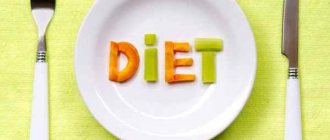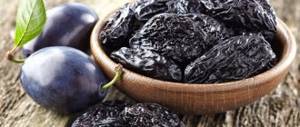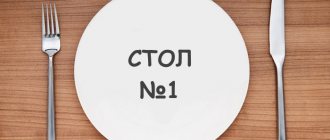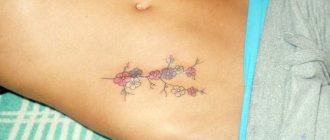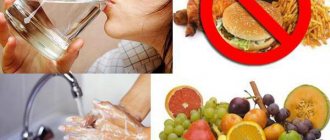The conditions of modern life and harmful human addictions contribute to increasing the impact of negative factors on the liver of a toxic nature (including drugs), viruses, and traumatic injuries.
It is important that the organ is able to compensate for its insufficiency for a long time by overloading the liver cells. But sooner or later a person begins to feel signs of liver failure. At this time, a therapeutic diet for liver disease can provide enormous assistance in therapy.
It is important for patients to know what can be eaten and what should be excluded from the diet to restore and support the organ during the initial symptoms of failure. The final result of the pathology is the development of irreversible cirrhosis, which is why it is so important, with the help of dietary nutrition, to delay the process of fibrosis, brain damage (hepatic encephalopathy), kidney damage due to accumulated unrecovered nitrogenous wastes, and heart muscle.
What diet is most appropriate for a diseased liver?
For various pathologies of internal organs, variants of dietary rules have been developed, which, according to the classification of M.I. Pevzner are called “tables”. The proposed diet for liver problems is called table No. 5. It is prescribed for inflammatory diseases, poisoning and intoxication, concomitant pathology of the biliary system, cirrhosis.
The goals of proper nutrition for liver disease are:
- support of the required level of metabolic processes in hepatocytes;
- restoration of the ability to process toxic substances;
- preventing the spread of cirrhotic changes and replacement of parenchyma with unhealthy tissue;
- normalization of the function of bile formation, movement of bile through the ducts.
Authorized Products
Products that are recommended to be consumed for diseases of the liver and gall bladder should help to completely relieve not only these organs, but the entire body as a whole. All foods must be boiled, steamed or baked without forming a crust.
In case of illness of these vital organs, the following may be consumed:
- rosehip decoction, natural juices without added sugar, weak tea with lemon;
- vegetarian soups, milk, pea, beet soup;
- buckwheat, oatmeal, semolina porridge;
- lean varieties of meat and fish;
- vegetables and fruits, boiled or baked;
- low-fat or low-fat dairy products;
- casseroles made from cottage cheese, rice or vermicelli.
Basic nutritional requirements for liver diseases
In addition to strict restrictions on certain types of products, taking into account the beneficial and harmful properties of dishes, the diet requires compliance with the following rules:
- meals should be carried out at least five times a day;
- single servings should not exceed 200 g, overeating is unacceptable and causes significant overload and complicates the course of diseases;
- fried, smoked, canned food is excluded, it is allowed to prepare dishes by boiling, steaming, stewing, a diseased liver reacts heavily to irritation, spasm of the bile ducts causes pain;
- in order to mechanically spare the digestive process, all dishes should be crushed in a blender, minced or pureed, thus reducing the overall load on digestion and reducing the reflex production of juices;
- finished products are suitable for feeding the patient if they correspond to a temperature range of 15 to 50 degrees; the liver does not tolerate deviations and contrasts.
Diseases of the liver and gall bladder, basic principles of nutrition
You will have to give up alcohol!
The liver is one of those organs in the human body that endures enormous loads every day. And in order for it to work as it should, it is necessary to “pity” it, that is, to lead the right lifestyle. Unfortunately, 90 percent of the world's inhabitants begin to monitor their diet only when problems have already begun to manifest themselves. This is especially true for the liver. There are several basic principles of nutrition if a person has one or another liver disease:
- In total, up to 2,500 calories should be consumed per day, especially if a person suffers from hepatitis
- You need to eat several times a day and in small portions. This is approximately four to six times a day, depending on your daily routine and opportunity. But 4 is the minimum number of techniques
- You can only eat boiled and steamed foods, because they do not put much strain on the gastrointestinal tract
- It is necessary to completely avoid fried foods. Such prepared dishes are quite heavy, and a diseased liver simply cannot cope with them
- You should only eat warm foods. Under no circumstances should you eat cold or hot, as such changes negatively affect the mucous membranes.
- You need to eat more foods containing fiber, as it stimulates the excretion of bile in the body
As for the gall bladder, the principles of nutrition are the same, because these two organs are closely interconnected, and what is good for the liver will be good for the gall bladder.
What foods should you exclude from your diet?
Patients with liver pathology should not eat foods containing high amounts of animal fats and light carbohydrates, which have a toxic and irritating effect. Table 5 highlights the following foods that are harmful to the liver, which are recommended to be avoided:
- wheat bread, butter bread, pastries, culinary products with cream, puff pastry;
- rich soups from meat, fish, cabbage, mushrooms;
- fatty meat, fish, duck in main courses;
- lard, cooking fat;
- “coarse” cereals (barley, millet, egg porridge, corn flakes);
- legumes (peas, beans, lentils);
- high-fat dairy products (whole milk, cream, sour cream, kefir, cottage cheese, processed cheese);
- vegetables that have a juice stimulating effect (radishes, white cabbage, turnips, radishes);
- greens with a high concentration of oxalic acid (spinach, garlic, onions, parsley, sorrel);
- chocolate and candies;
- sour berries and fruits;
- hot seasonings (pepper, horseradish, mustard), ketchups, sauces, mayonnaise;
- carbonated drinks, strong tea, cocoa, coffee;
- alcohol in any form (drinks, tinctures);
- ice cream.
Prohibited foods and dishes
Patients with liver and gallbladder diseases cannot eat many foods. You should refuse:
- fatty products (pork, lamb, pastries, cakes, etc.),
- mushrooms,
- lard,
- broths (mushroom and meat),
- butter,
- fatty cheeses,
- fat cottage cheese,
- canned food,
- margarine and lard,
- fatty fish,
- seasonings,
- smoked meats,
- some types of greens and vegetables,
- fresh rye bread,
- chocolate,
- ice cream,
- alcohol,
- sweets,
- coffee and coffee drinks,
- carbonated drinks,
- cocoa,
- strong tea,
- nuts,
- sour fruit juices.
What can you eat?
Doctors believe that a diet to restore the liver cannot be hypocaloric. If the main organ that produces energy for the body suffers, then to support it, healing food substances are needed to compensate for the loss. The calorie content of the menu for each day is 2800–3000 kcal.
The following products are allowed:
- rye or rye-wheat bread, dried, in the form of crackers;
- lean meat and fish, chicken, turkey, squid, shrimp, veal, rabbit;
- low-fat dairy products (milk, cottage cheese, kefir, hard cheese);
- from cereals - buckwheat, oatmeal, rice, semolina;
- a wide variety of vegetables - potatoes, beets, carrots, sweet peppers, onions (preferably blue), cucumbers, zucchini, tomatoes, pumpkin;
- berries and fruits of sweet varieties;
- eggs are limited, only whites in an omelet, a boiled yolk can be grated into porridge once a week (nutritionists have different opinions, some believe that you can eat up to three eggs a week, and limit the yolks only in cases of a combination of liver damage and cholelithiasis);
- pasta made from premium flour;
- drinks from berries and fresh or dried fruits in compotes, decoctions, jelly, non-canned juices, a decoction of rose hips is highly recommended, only weak tea;
- nuts (walnuts are better, peanuts are excluded), pumpkin seeds;
- butter is combined with vegetable oil, preferably added directly to the plate;
- honey, marmalade, marshmallows, jam, dry cookies or biscuits are allowed to a limited extent (sugar is often replaced with xylitol).
Rationale for the beneficial properties of foods included in a therapeutic diet for the liver
The diet provides certain foods with food ingredients that improve liver function. Since their choice is important for shaping the patient’s diet, we will focus separately on explaining the appropriateness of use. The main source of proteins is meat and fish, dairy products, limited eggs
In the diet, you will need to use only low-fat varieties, since animal fat contains a high concentration of cholesterol and aggravates the fatty degeneration of liver cells. Legumes are known for their protein properties, but they are difficult to tolerate by the digestive system, cause bloating and increased fermentation in the intestines, and are therefore not recommended.
To normalize fat metabolism in the diet, lipotropic substances are needed that restore the active processing of liver lipids into energy, stimulating the excretion of fatty acids with bile into the intestines to combat fatty infiltration.
The maximum lipotropic effect is found in cottage cheese, seafood, fish, eggs, lean beef, and soy flour. Plant fiber has moderate lipotropic properties. It also improves intestinal function, which means it promotes the accelerated elimination of cholesterol.
Fiber - found in all vegetables and fruits (the concentration is maximum in dried fruits), in the fresh juices of apples, pumpkins, beets, and avocados. Wheat bran is added to the diet. The medicinal value of beets for the liver also lies in the increased content of pectin and betaine.
The lipotropic effect is enhanced by polyunsaturated fatty acids. The most famous of them are: omega-3, omega-6, arachidonic, linolenic. They are contained in sufficient quantities in vegetable oils (linseed, corn, olive, sunflower, milk thistle). Therefore, the diet requires their use instead of animal fats.
Comments from nutritionists
If the liver doesn’t bother us, we don’t think about it and don’t think about the harm we cause to this organ by eating fatty and fried foods, alcohol, chemical additives or medications. Healthy nutrition, which is Table No. 5 , spares it, improves the function and general condition of the patient, and also prevents exacerbation and progression of the disease. It is known that each exacerbation of hepatitis leads to the progression of liver tissue fibrosis.
This is a complete and proper diet, which is balanced with all the necessary nutrients and vitamins and must be adhered to constantly. Sources of protein in the diet include lean meat, fish, dairy products and eggs. Although legumes are also a source of easily digestible protein, they are poorly tolerated by gastroenterological patients, and such products are limited or excluded altogether.
The diet contains products containing lipotropic substances that normalize lipid metabolism and stimulate the removal of fat from the liver, which prevents its fatty infiltration. Lipotropic foods include cottage cheese (of moderate fat content), eggs, lean beef, fish and seafood, soy and soy flour. By the way, fiber also has a lipotropic effect, which enhances intestinal function and promotes the elimination of cholesterol.
Fiber is a healthy product for the liver. It is contained in all vegetables and fruits, and especially dried fruits, avocados, freshly squeezed juices (apple, beetroot, pumpkin), wheat bran and pectin (apples, beets). The latter also contains betaine , which makes it a product of high dietary value.
Polyunsaturated fatty acids (arachidonic acid, omega-3 , omega-6 ) also have a lipotropic effect. We get these acids from vegetable oils (linseed, olive, corn and others), so the diet includes their introduction instead of refractory animal fats. Linolenic acid is not synthesized in the body and must be obtained from food.
For liver diseases, you can consume 450 g of carbohydrates, of which 100 g are easily digestible. Carbohydrates are easily digestible and do not burden the liver, and thanks to them, you can maintain the calorie content of your diet while limiting fat. A sufficient amount of carbohydrates is necessary to ensure glycogen reserves in the liver. Their main sources in the diet are: sugar, cereals, bread, vegetables (carrots, beets, potatoes), fruits (grapes, bananas, persimmons), nuts, honey.
You can also name four useful and essential vitamins:
- Vitamin A (contained in red-orange vegetables).
- Vitamin C (in descending order contains: dried rose hips, sea buckthorn, red peppers, Brussels sprouts, dill, kiwi, cauliflower, oranges, strawberries, spinach, kohlrabi, white cabbage, grapefruit, lemon).
- Lipoic acid (dairy products, beef liver, spinach, rice, lean beef, broccoli and cabbage, carrots, beets). This is a vitamin-like substance, an antioxidant that helps maintain liver health and restore the integrity of its cells. It has a lipotropic effect (prevents fatty degeneration) in hepatitis and hepatosis . Taking part in fat metabolism, it shifts the spectrum of lipids towards unsaturated fatty acids, reduces cholesterol , preventing atherosclerosis .
- Vitamin E (cereals, fish, olive and other oils).
Features of nutrition for liver diseases
Therapeutic nutrition for the liver is table No. 5. The diet is strict, but balanced - the food excludes foods with a high concentration of cholesterol, fats, oxalic acid and purine, which can irritate injured tissues and increase the load on them.
The main nutritional features of the fifth diet that must be followed:
- grind vegetable products containing a lot of fiber, cut the meat into small pieces, boil well;
- eat frequently and in moderate doses - at least 5 meals per day;
- Dishes are suitable for consumption only when warm;
- cooking food - steaming, boiling or baking in the oven - frying is excluded, sometimes food can be stewed;
- daily salt intake should not exceed 10 g.
What can you eat if you have liver problems?
Special nutrition does not accept junk food and involves enriching the diet with boiled or raw (necessarily grated) vegetables, fruits, juices, and low-fat foods.
Table "Useful products"
| Product category | Authorized products |
| Bread, flour products, confectionery | Dried bread, with bran, rye, crackers, cookies with a minimum sugar content, baked goods without yeast (baked pies, dumplings with cottage cheese, dumplings with meat), dried biscuit |
| Porridge, pasta, seeds | Rice, buckwheat, oatmeal, semolina, muesli, bulgur, millet, flax seeds, noodles, spaghetti, pasta |
| Sweets | Berries, fruits (baked with sugar or honey), marshmallows, marmalade, fruit mousses, jellies, gingerbread cookies, biscuits, caramel and marmalade candies |
| Greens, vegetables | Zucchini, Chinese and cauliflower, carrots, pumpkin, beets, potatoes, celery, lettuce, cucumbers, tomatoes (do not eat in case of exacerbation), seaweed, broccoli beans in pods, avocado, sweet peppers, onions, parsley, dill |
| Berries, fruits (soft, ripe, sweet), dried fruits | Apples, bananas, watermelon, dried melon and papaya, prunes, raisins, dried apricots, pineapples |
| Beverages | Weak green tea, compote, jelly, skim milk, still water, rosehip infusion, low-calorie fermented milk drinks - kefir, fermented baked milk. 200 ml per week you can carrot juice, tomato juice, beet juice, |
| Low-fat dairy products | Yogurt, cottage cheese, butter, cheese |
| Meat | Dietary varieties - rabbit, beef, horse meat, veal, turkey, chicken |
| Fish, seafood | Lenten species - pike perch, cod, tuna, hake, pollock. Mussels, shrimp, squid, salmon - no more than 100 g in 2-3 days |
| Eggs | Steamed omelettes from quail and chicken eggs. In case of an enlarged liver or acute inflammation, it is better to exclude the yolk or limit its consumption as much as possible |
| Oil | Sunflower, olive – 1–2 tbsp. l. |
| Seasonings | Soy sauce, cinnamon, vegetable sauces without frying or spicy additives |
What should you not do if you have liver disease?
When dieting, you should not eat food that can irritate tissues during liver inflammation, increase the load on healthy hepatocytes and provoke stagnation in the injured organ.
Eliminate chocolate from your diet
Table "Junk food"
| Product category | Prohibited Products |
| Bread, confectionery, flour products | Butter, yeast baked goods, puff pastry, deep-fried pies, belyashi, pasties, pancakes, cream products, fresh bread |
| Porridge, pasta, seeds | Beans, lentils, corn porridge, pearl barley, barley porridge, sunflower and pumpkin seeds |
| Sweets | Kozinaki, halva, sunflower seeds, sherbet, popcorn, waffles, cream desserts, chocolates, products with nuts, sesame seeds, ice cream |
| Greens, vegetables | Olives, mushrooms, ginger, green onions, asparagus, radishes, radishes, spinach, arugula, parsley, dill (in large quantities), corn, sorrel, garlic, pickled cucumbers, tomatoes (tomato paste), raw white cabbage |
| Berries, sour fruits, nuts | Raspberries, oranges, figs, grapes, lemon, pomegranate, melon, dates, persimmons, pears, walnuts and hazelnuts, almonds, peanuts |
| Beverages | Hibiscus, strong black and green tea, cocoa, chocolate drinks, fruit and vegetable juices with preservatives and dyes, any drinks containing alcohol, coffee, sparkling water, herbal decoctions based on knotweed, stevia |
| High fat dairy products | Cottage cheese, milk, yogurt, kefir, fermented baked milk, salted cheeses |
| Meat | Beef and lamb fat, pork, smoked meat by-products (sausages, balyki, lard), tongue, kidneys, liver, canned food |
| Fish, seafood high in fat | Carp, trout, sturgeon, stellate sturgeon, salmon, beluga, catfish, mackerel, and derivatives - caviar, crab sticks, sushi |
| Eggs | Fried eggs |
| Seasonings, oil | Hot sauces, ground pepper, seasonings for frying meat, mustard, ketchup, mayonnaise, adjika, spices, unrefined oil |
Sample menu for the week
The list of allowed foods for a diseased liver allows you to eat varied and tasty, trying something new every day.
Make a menu for the week from the list of allowed foods to eat tasty and varied
Table "Weekly menu"
| Day of the week | List of dishes |
| Monday | Breakfast: oatmeal, steamed rabbit cutlets, fresh grated apple, still water |
| 2nd breakfast: yogurt, cookies | |
| Lunch: beetroot soup, fish soufflé, bread, jelly, carrot juice | |
| Afternoon snack: a piece of biscuit, fermented baked milk | |
| Dinner: boiled fish, semolina, green tea | |
| Tuesday | Breakfast: beet cutlets, rice, jelly |
| 2nd breakfast: crackers, apple-banana soufflé, still water | |
| Lunch: broth with vegetables, stewed peppers with rice and boiled meat, cottage cheese casserole, compote | |
| Afternoon snack: salad with pineapple, banana and peach, dressed with sour cream | |
| Dinner: salad with olive oil and boiled beets, kefir | |
| Wednesday | Breakfast: semolina, baked apple, biscuits, green tea with honey |
| 2nd breakfast: baked apple pie, carrot juice | |
| Lunch: dumplings with minced chicken, tomato juice, oatmeal cookies | |
| Afternoon snack: marshmallows, compote | |
| Dinner: boiled chicken fillet, buckwheat, bread, low-fat milk, crackers | |
| Thursday | Breakfast: muesli with dried fruits, jelly, cookies |
| 2nd breakfast: yogurt, a piece of biscuit | |
| Lunch: vegetable pilaf, seaweed and boiled shrimp salad, bread, carrot juice, marmalade | |
| Afternoon snack: dumplings with potatoes, tomato juice | |
| Dinner: oatmeal, steamed meatballs, rosehip broth, croutons | |
| Friday | Breakfast: beetroot and squash soup, cabbage cutlets, bread, carrot juice |
| 2nd breakfast: baked apples with cottage cheese, warm chamomile infusion | |
| Lunch: fish balls with sour cream, buckwheat, kefir | |
| Afternoon snack: banana, cookies, honey drink (200 ml warm water, 2 tsp honey) | |
| Dinner: fish soufflé, vegetable pilaf, fermented baked milk, croutons | |
| Saturday | Breakfast: pasta soup, beet cutlets, tomato juice |
| 2nd breakfast: marmalade, banana, compote | |
| Lunch: buckwheat, beef cutlets, bread, jelly, cookies | |
| Afternoon snack: dumplings with strawberries, mint tea | |
| Dinner: semolina, soup with dumplings, raspberry compote | |
| Sunday | Breakfast: oatmeal, boiled chicken breast, fruit mousse |
| 2nd breakfast: dry biscuits, fermented baked milk | |
| Lunch: mussel soup, seaweed, rice, carrot juice | |
| Afternoon snack: lazy dumplings, rosehip decoction | |
| Dinner: vegetable soup, bread, beetroot cutlets, still water |
Healthy food recipes
Recipes for dietary dishes imply a successful combination of products and cooking methods, which allows you to eat healthy, restoring the functions of the affected organ in the acute or chronic stage of the disease.
Beetroot cutlets
Beetroot cutlets are a great addition to any side dish.
Boil 2 large beets, peel, chop with a fine grater, add finely chopped onion (1 piece), white of 1 egg, salt. Mix everything, form small cutlets and place them on a baking sheet. Bake for 20 minutes at 180 degrees.
Vegetable soup with dumplings
You will need: potatoes (2 pcs.), 1 medium onion, 100 g flour, salt, 1 beet, 1 carrot, cabbage inflorescences from half a head, low-fat milk (50 ml), dill, parsley.
Boil 2 liters of water, cut the vegetables into small pieces. Place the potatoes and beets into the broth, after 12 minutes add the rest of the vegetable ingredients and add salt. Prepare the dumplings - pour milk into the flour, stir until a homogeneous paste is formed, which should be lowered into boiling water using a teaspoon a few minutes before the soup is ready, forming small balls. Sprinkle with herbs (parsley, dill), remove from heat.
Oatmeal soup
You can expand the menu of first courses with soup with oatmeal
Finely chop 3 potatoes, place in boiling water (500 ml) and boil for 15 minutes. Gradually add 50 g of large flakes into the broth, stir and leave on low heat until all the ingredients are cooked. At the end, sprinkle with herbs.
Steam omelette with vegetables
- zucchini 1 pc.;
- sweet pepper - 1 pc.;
- cauliflower – 100 g;
- skim milk – 50 ml;
- butter – 20 g;
- egg white from 3 eggs.
Fry finely chopped vegetables with 30 ml of milk in vegetable oil for 10 minutes. Beat the egg whites with the rest of the milk, add salt and pour over the vegetables, stir, sprinkle with herbs and bake in the oven at 180 g until golden brown.
Cabbage and rice casserole
Casserole with rice and cabbage - a tasty and healthy dish when on a diet
Pre-boil 0.5 cups of rice. Separately mix 2 tbsp. l. semolina and 50 ml of milk, leave for 10 minutes. Add rice, 300 g of chopped cabbage, stir. Place the mixture in the pan and bake until done.
Curd pudding in a water bath
Grind 150 g of cottage cheese through a sieve, pour in 70 ml of milk, 1 egg, 2 tbsp. l. sugar and mix well. Grease the container with vegetable oil, pour out the curd mass and place in a water bath. Cooking time: 25–35 minutes.
Beet salad with broccoli and green beans
Green beans and broccoli will help diversify a regular beet salad.
Boil 1 beet, 150 g bean pods, 300 g broccoli, cut into cubes, add salt. Add a little dill and parsley, season with olive oil.
For people suffering from liver disease, proper nutrition is the best way to improve the quality of life and put the pathology into remission. Table No. 5 is a gentle diet that eliminates chemical and mechanical effects on the injured organ and helps restore the basic functions of the main filter of the human body.
Rate the article ( 5 ratings, average 4.80 out of 5)
The liver and pancreas are important human organs. If they do not work correctly, human life will be in danger. Leading an active lifestyle and proper balanced nutrition restores the natural functioning of these organs.
Recipes for dietary dishes to restore the liver
The first recipe that is good for the liver is a puree soup based on pumpkin and oatmeal:
- Cook 100 g of peeled and diced pumpkin until half cooked.
- Place the pumpkin in a deep frying pan, add 2 tbsp. l. oatmeal, 0.5 tsp. butter, a little pumpkin broth.
- Simmer covered for another half hour, then grind everything in a blender, add a little sugar, and also pumpkin broth.
Steamed beef cutlets:
- Make minced meat from 150 g of beef and 30 g of stale white bread soaked in milk using a meat grinder/blender.
- Add salt and dilute with water.
- Form cutlets and steam for about half an hour.
Egg white sponge cake:
- Mix 6 egg whites with 1/3 cup sugar and beat.
- Add 1 cup of crushed white bread croutons into the resulting foam.
- First pour half of the mixture into the greased form, sprinkle with 1-2 tbsp. l. poppy seeds, and then the remaining half.
- Bake in the oven at 180°C.
- How is HIV transmitted?
- Chicken fillet rolls with filling - recipes
- Preparing salted eggplants for the winter
Principle of nutrition for liver disease
Today, doctors recommend a special list of products that help with liver and pancreas diseases. They are recommended not to consume fats and other difficult-to-digest foods, not only during the diet, but also in the future. This way the disease will not progress and bother the patient.
The main components that need to be included in the diet are as follows::
- Fast-digesting proteins;
- Carbohydrates;
- Mineral Components;
- Vitamins.
If the disease of the liver and pancreas has worsened, the diet of patients should be based on the following products:
- Dairy and fermented milk products: low-fat sour cream, kefir, milk, cottage cheese, fermented baked milk;
- Durum pasta: consume in moderation;
- Porridge: rice, buckwheat, oatmeal, bulgur;
- White fish;
- Eggs in low-fat dishes or as an omelet (quail and chicken);
- Greens and vegetables. Limit your intake of legumes and vegetables containing fiber;
- Fruits (except grapes and bananas);
- Honey is an excellent sugar substitute. Take a teaspoon during tea drinking.
For salads and other dishes, vegetable oil is used, which promotes the effective restoration of the pancreas and liver during the diet:
When preparing first courses, use clean water and vegetable broth. Pay considerable attention to milk soups, since dairy products are easily absorbed in the body, providing lightness. In addition, they give you a feeling of fullness. as a result, the patient will not be hungry for several hours.
During diet and treatment, gastroenterologists recommend limiting sugar intake. But some sweets are still allowed:
- Jelly;
- Marshmallow;
- Fruit or berry mousse;
- Paste;
- Oatmeal cookies;
- Marmalade and unsweetened jam.
For the course of treatment to be effective, maintain water balance (1.5 liters of clean water per day).
If you have liver and pancreas disease, pay special attention to the following drinks:
- Weak black tea (preferably loose leaf);
- Homemade compotes from dried fruits and berries;
- Kissel, which contains natural berries;
- Fruit, berry and vegetable juices;
- Clean water.
General recommendations
Proper nutrition for liver and gallbladder diseases includes adherence to the following principles:
- per day you should consume no more than 2500 calories;
- You should eat food in small portions;
- there should be five to six meals a day;
- Food should be steamed or boiled. Only dishes prepared in this form will not burden the digestive tract;
- Fried and fatty foods are strictly prohibited. This is too heavy food, which will be difficult for a diseased liver to cope with;
- eat food warm. Cold and hot food only harm the mucous membrane;
- the menu should contain a sufficient amount of protein food - 80–90 g per day;
- the amount of fat consumed per day also ranges from 80–90 g. If there is more fat, it will only burden the liver. Also, an insufficient amount of them will negatively affect the condition of the organ. Fats of animal origin are absorbed much better than vegetable fats, so they should predominate in the diet;
- for carbohydrates, 100 g per day is allocated. There are light and complex carbohydrates. Easily digestible foods, for example, include sugar and honey; their quantities should be strictly limited. The source of complex carbohydrates is porridge;
- Products containing fiber stimulate the production and excretion of bile secretions.
A specialist will help you choose an effective diet for liver and gallbladder diseases.
Important! Fat promotes better absorption of vitamins and nutrients, which is why a diet for liver disease must necessarily include animal fats.
Let's highlight useful foods for the liver and gallbladder:
- dairy products: kefir, cream, sour cream, milk, cottage cheese;
- soups made with vegetable broth without frying. You can add a little vegetable oil there;
- fruit and milk soups;
- lean fish and meat, boiled or baked, or best steamed;
- oil. Butter, olive and sunflower oil are allowed, but in small quantities;
- one egg yolk is allowed per day, added to some dish;
- oatmeal and buckwheat in viscous form are useful;
- boiled or oven-baked vegetables;
- berries and fruits, except citrus fruits;
- fruit juices, rosehip infusion, as well as green and black tea.
Porridges for liver and gall bladder diseases should be crumbly or viscous. But there are also prohibited foods that patients should avoid. These include fatty fish and meat, as well as lard, fried foods, fatty broths, smoked meats, cervelat, canned food, offal, mushrooms, legumes, coffee, and confectionery.
Important! Alcoholic drinks are strictly prohibited, as they will further destroy liver cells and cause intoxication.
Now let’s summarize all of the above and consider an approximate menu for one day for a sick person. It may look like this:
- breakfast. Vinaigrette with sour cream, black tea with milk, toasted bread and low-fat cottage cheese;
- lunch. Rosehip decoction;
- dinner. Baked chicken breast with vegetables, as well as viscous buckwheat porridge. Fruit juice;
- afternoon tea Boiled lean fish with sauerkraut;
- dinner. Cottage cheese casserole, vegetable cutlets and compote;
- Two hours before bedtime, you can drink fruit jelly with a bun.
Rosehip decoction is useful as a drink
Diet for liver cancer
Liver cancer is one of the most serious diseases of the digestive system. Over time, a tumor forms. The reasons for this are different:
- Cirrhosis of the organ;
- Advanced hepatitis;
- Products that contain aflatoxin B1.
Today's accelerated time dictates different rules, giving life to the preparation of quick food. Therefore, modern people do not use the right diet for liver and pancreas diseases. The menu becomes interesting when the disease process seriously progresses. Symptoms appear that indicate problems in the body and disease. Pay special attention to the diet menu.
Menu for the day
Breakfast number 1:
- Half a glass of freshly squeezed carrot juice.
Breakfast No. 2:
- Vegetable stew;
- One glass of skim milk;
- Homemade noodles.
Dinner:
- Fruit or vegetable salad with low chemical content;
- Chicken soup or other dietary meat;
- Dried bread;
- Potatoes from the oven;
- Black tea is not strong.
Afternoon snack:
- Jelly made from fruits and berries, squeezed in a juicer.
Dinner:
- A small piece of cottage cheese casserole, millet porridge and one slightly warmed glass of milk.
Before bedtime:
- Natural yoghurt and home-cooked fruit.
Video: therapeutic nutrition for liver cirrhosis
The diet for hepatitis C, cancer or cirrhosis of the liver requires general nutritional rules, but there are some differences for each disease. They relate to the list of allowed/prohibited foods, daily calorie content, and the composition of the diet for 1 day. To learn about the nuances of nutrition for liver cirrhosis, watch the useful video below and create your own menu.
Among liver pathologies, the leading place is occupied by hepatitis of viral and toxic origin. It is difficult to cure these ailments, and it takes a lot of time (from 3 months to several years). Unfortunately, there are no drugs that guarantee complete restoration of liver tissue. Therefore, diet for liver disease is key.
Treatment of pathologies of this important organ should be comprehensive: medications, giving up bad habits, an active lifestyle, proper nutrition. It is important not only to choose the right products, but also to prepare them correctly, take into account the temperature of the dishes, and the time of eating. If these rules are followed, the functionality of the gland is restored, digestion improves, the immune system is strengthened, and weight is normalized.


